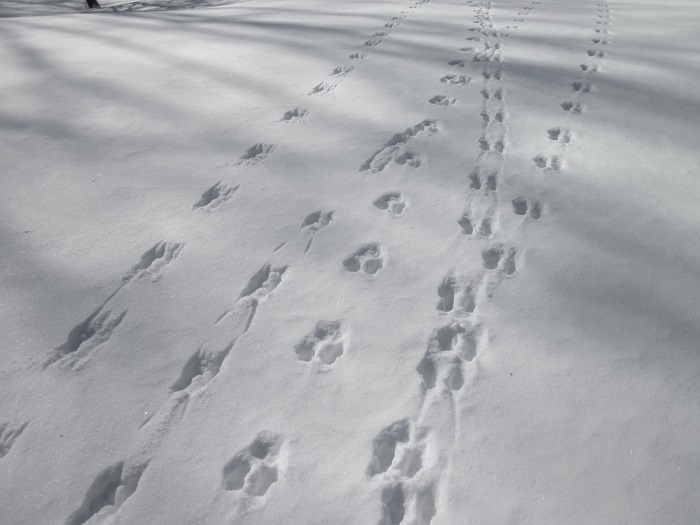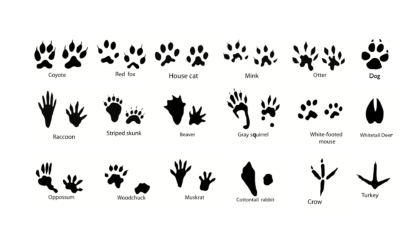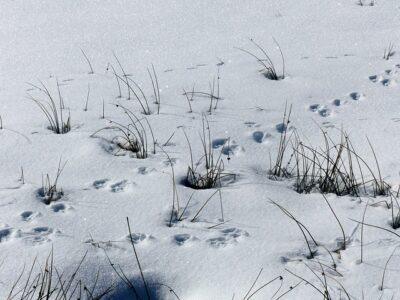|
Listen To The Article
|
For those of us who live in the North, winter snows bring an unexpected benefit: It is much easier to find and follow animal tracks. If you are a novice tracker, or if you would like an opportunity to deepen your skills, winter is an excellent time. It is possible to find very clear tracks and trails, distinguish regular runs, and even detect how recently an animal traveled by, as determined by the snowfall.
The best tracks are found after a new snowfall, early in the morning as the sun is rising. If you are in a populated area, dogs and people will spoil most trails quite soon after sunrise. In the country, tracks can remain pristine all winter if conditions permit it. You will have to take note of how recently snow and other precipitation falls and learn to read the snow, in order to determine the age of a track. For example: Imagine your region has a powdery snowfall, and then an ice storm, and then a powdery snowfall again. Fresh tracks would be in powdery snow on top of ice. Any frozen tracks would be older than the storm, and probably useless except as a curiosity. Keeping a log of the weather is useful for trackers.
Tracking For Beginners
If you are an absolute beginner, you must first learn which animals make which tracks. Even near your homestead you should see patterns of prints leading in various directions. You may notice animals near tracks, as well. Keep a logbook of tracks, sketching them and noting which animals were nearby, the conditions, and if you could find a trail. You also can purchase a guidebook picturing local animals and their tracks, but you will still need to learn to recognize them in the wild; tracks look differently in snow and mud than on paper.
A hike in the snowy woods should yield many examples of tracks. This, in itself, is excellent fun, and no opportunity to look for prints in the woods should be wasted. Challenge yourself and your family to identify as many of the local animals by track alone as possible. However, identifying animals is only part of tracking; you need more information before you’ll catch anything. After you find an animal track, you must also locate its trail and establish the age of the trail.
Safety First
In winter, there are many clues offered by following an animal’s trail. In this case, you will be leaving established walking paths and moving into the woods, so exercise caution. It is very easy to become disoriented when you are following tracks. Begin in country in which you are familiar and know the surrounding topography, and travel with at least a basic understanding of orienteering. Never venture into the winter wilderness without proper survival gear. Don’t track bears, wolves, moose, cougars or other large animals without proper training and a firearm. Knowledge of weather won’t hurt, either; suffice it to say it’s better to watch the storm hit from indoors.
Successful Tracking
On a fair winter day after snowfall, find a clear track on your normal route, identify it, and begin to follow in its direction of travel. Don’t walk on the tracks, but nearby, marking them in the snow or with blazes on nearby trees. If you plan to hunt, it is valuable to know the behavior of your intended catch. Many animals will travel similar routes, seeking food and especially water. If you find one of these routes, called a run, you likely will be able to find the animal. In the case of small game, you could set traps along a run to catch animals for food; with larger game, you would likely set up a blind for hunting nearby. The real objective of tracking is determining where the animal is, or will be, not where they were.
The End Of The Trail
Another destination that trails may take you is a den or cover. You will know you have found an animal’s home when you see many tracks leading into it — food scraps, droppings, or the den itself. Try not to despoil the area; you don’t want to make your presence felt. It is better to know more about the animal’s whereabouts than it knows about yours. If you find an animal’s home, you can watch the area to find a good location for hunting. Consider hunting a distance away from a den or cover; other animals may use it, and if you hunt there you may drive them away, but if you hunt nearby you may catch more.
With practice and regular travel into the winter woods, you will be able to identify tracks and know the patterns of your animal neighbors – a skill that could prove invaluable one day.
What advice would you add on tracking animals? Share your advice in the section below:
Learn How To ‘Live Off The Land’ With Just Your Gun. Read More Here. [4]



